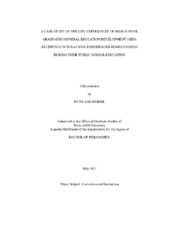| dc.contributor.advisor | Larke, Patricia | |
| dc.creator | Reider, Ruth Ann | |
| dc.date.accessioned | 2012-07-16T15:56:24Z | |
| dc.date.accessioned | 2012-07-16T20:21:11Z | |
| dc.date.available | 2012-07-16T15:56:24Z | |
| dc.date.available | 2012-07-16T20:21:11Z | |
| dc.date.created | 2011-05 | |
| dc.date.issued | 2012-07-16 | |
| dc.date.submitted | May 2011 | |
| dc.identifier.uri | https://hdl.handle.net/1969.1/ETD-TAMU-2011-05-9064 | |
| dc.description.abstract | The National Law Center on Homelessness and Poverty (NLCHP, 2007) recently reported that there were 1.3 million homeless children living in the United States. The voices of homeless children and youth are often silent, as the literature generally reflects their experiences only indirectly, as related by care givers or social service providers. In contrast, this study provides firsthand accounts of the difficulties encountered by children and youth who struggle to complete their educations while being homeless. This qualitative case study examines the personal and educational experiences of seven adults who had been homeless as children or youth and who graduated from high school or earned their General Education Development (GED) equivalents.
Two research questions framing this study were: 1. What do the voices of adults who received a high school diploma or GED tell us about their life experiences as a homeless student? 2. What do the voices of adults who received a high school diploma or GED tell us about their educational experiences as a homeless student?
Purposeful sampling was used to locate participants. The population of this study was culturally diverse and included African American and European American individuals currently between the ages of 18 and 51 years. Data was generated via interviews using a protocol designed by the author. This instrument included both fixed and open-ended questions designed to allow participants the opportunity to share their educational and personal experiences. Various forms of documents were also consulted.
The constant comparative method was used to analyze the data. Three categories regarding the life experiences of homeless children and youth emerged from the study; family, the road to homelessness and homelessness. Two categories were identified pertaining to educational experiences; determination or self-motivation and sources of support. The participants' testimonies confirmed some of the existing literature regarding homeless children and youth and, in particular, supported research conducted on the attributes of resiliency. In addition, participant narratives provided insight into the struggles of a marginalized segment of the school population by allowing us to hear their stories in their own words.
The National Law Center on Homelessness and Poverty (NLCHP, 2007) recently
reported that there were 1.3 million homeless children living in the United States. The
voices of homeless children and youth are often silent, as the literature generally reflects
their experiences only indirectly, as related by care givers or social service providers. In
contrast, this study provides firsthand accounts of the difficulties encountered by
children and youth who struggle to complete their educations while being homeless.
This qualitative case study examines the personal and educational experiences of seven
adults who had been homeless as children or youth and who graduated from high school
or earned their General Education Development (GED) equivalents.
Two research questions framing this study were:
1. What do the voices of adults who received a high school diploma or GED
tell us about their life experiences as a homeless student?
2. What do the voices of adults who received a high school diploma or GED
tell us about their educational experiences as a homeless student?
Purposeful sampling was used to locate participants. The population of this study
was culturally diverse and included African American and European American
individuals currently between the ages of 18 and 51 years old. Data was generated via
interviews using a protocol designed by the author. This instrument included both fixed
and open-ended questions designed to allow participant the opportunity to share their
educational and personal experiences. Various forms of documents were also consulted.
The constant comparative method was used to analyze the data. Three categories
regarding the life experiences of homeless children and youth emerged from the study;
family, the road to homelessness and homelessness. Two categories were identified
pertaining to educational experiences; determination or self motivation and sources of
support. The participants' testimonies confirmed some of the existing literature
regarding homeless children and youth, and in particular supported research conducted
on the attributes of resiliency. In addition participant narratives provided insight into the
struggles of a marginalized segment of the school population by allowing us to hear their
stories in their own words. | en |
| dc.format.mimetype | application/pdf | |
| dc.language.iso | en_US | |
| dc.subject | Homeless | en |
| dc.subject | Resilient | en |
| dc.subject | Runaway | en |
| dc.title | A Case Study of the Life Experiences of High School Graduates/General Education Development (GED) Recipients in Texas Who Experienced Homelessness During Their Public School Education | en |
| dc.type | Thesis | en |
| thesis.degree.department | Teaching, Learning, and Culture | en |
| thesis.degree.discipline | Curriculum and Instruction | en |
| thesis.degree.grantor | Texas A&M University | en |
| thesis.degree.name | Doctor of Philosophy | en |
| thesis.degree.level | Doctoral | en |
| dc.contributor.committeeMember | Carter, Norvella | |
| dc.contributor.committeeMember | Slattery, G. Patrick | |
| dc.contributor.committeeMember | Clark, M. Carolyn | |
| dc.type.genre | thesis | en |
| dc.type.material | text | en |


